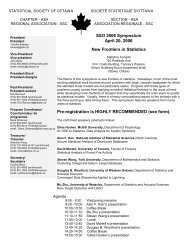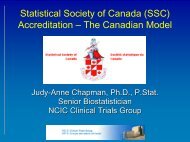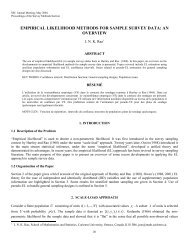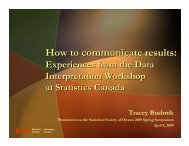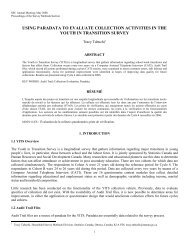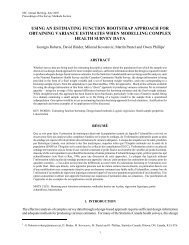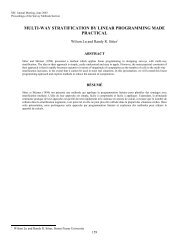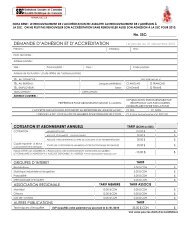Programme et résumés (pdf) - Société statistique du Canada
Programme et résumés (pdf) - Société statistique du Canada
Programme et résumés (pdf) - Société statistique du Canada
Create successful ePaper yourself
Turn your PDF publications into a flip-book with our unique Google optimized e-Paper software.
144 Mercredi 31 mai • Wednesday, May 31, 08:30–09:30[MS-172]A M<strong>et</strong>hodological Approach to Controlling Inter-monitor Variability in Computer Assisted TelephoneInterviewing OperationsUne approche méthodologique <strong>du</strong> contrôle de la variabilité entre les surveillants dans les opérationsd’entrevues téléphoniques assistées par ordinateurHansheng XIE & Walter MUDRYK, Statistics <strong>Canada</strong>Quality Control (QC) monitoring has been implementedin Computer Assisted Telephone Interviewingoperations of most social surveys at Statistics<strong>Canada</strong>. The QC monitoring has been demonstratedto be instrumental in lowering interviewererrors. However, the consistency and reliability ofthe monitors who evaluate and assess the interviewersremains a general concern of this technique.In this paper, we propose two m<strong>et</strong>hods to objectivelyevaluate inter-monitor variability over timeand d<strong>et</strong>ermine monitors’ consistency in assessinginterviewers.Statistique <strong>Canada</strong> a exécuté la surveillance <strong>du</strong> Contrôle dela Qualité dans les opérations de l’Interview TéléphoniqueAssistée par Ordinateur de la plupart des enquêtes sociales.C<strong>et</strong> exercice a contribué à diminuer les erreurs commisespar les interviewers. Cependant, c<strong>et</strong>te technique cause unecertaine inquiétude quant à la cohérence <strong>et</strong> la fiabilité dessurveillants qui évaluent les interviewers. Dans notre article,nous proposons deux méthodes pour évaluer objectivementla variabilité entre les surveillants au cours <strong>du</strong> temps ainsique pour déterminer objectivement la cohérence des sur-veillants lors de leur évaluation des interviewers.[MS-173]What to do when Survey Weights Weigh you DownQuoi faire quand les pondérations (les poids) d’une enquête pèsent sur vousPat NEWCOMBE, Statistics <strong>Canada</strong>Des chercheurs, employant des données d’enquête de Statistique<strong>Canada</strong>, sont parfois frustrés quand l’utilisation despoids d’enquête dans les modèles mène à des résultats diffé-rents de ceux obtenus sans l’utilisation des poids. Bien queStatistique <strong>Canada</strong> encourage fortement les chercheurs à em-ployer les poids afin de tenir compte <strong>du</strong> plan de sondage, lacomparaison des résultats pondérés <strong>et</strong> non pondérés demeureun outil diagnostique intéressant. Cependant, quand il y desdifférences, il n’est pas toujours facile de les justifier. C<strong>et</strong>article discute de différentes approches face à ce problème<strong>et</strong> de l’utilisation de méthodes graphiques assez simples quipeuvent être effectuées dans SAS.Researchers using Statistics <strong>Canada</strong> survey datasom<strong>et</strong>imes are frustrated when the application ofthe survey weights pro<strong>du</strong>ces model results notablydifferent from those obtained without the use ofweights. Although Statistics <strong>Canada</strong> strongly encouragesresearchers to use the weights to accountfor the sampling design, it is a useful diagnostictechnique to compare the weighted and unweightedresults. However, when there is a difference, it isnot always obvious how to "g<strong>et</strong> to the bottom ofit". This paper discusses approaches to this problem,including some fairly simple graphical m<strong>et</strong>hodswhich may be carried out in SAS.Session 09A Mercredi 31 mai • Wednesday, May 31, 08:30–09:30 SSC2050Pierre Robillard Award AddressAllocution <strong>du</strong> récipiendaire <strong>du</strong> prix Pierre-RobillardSH = Somerville House SSC = Social Science Centre UC = University College



